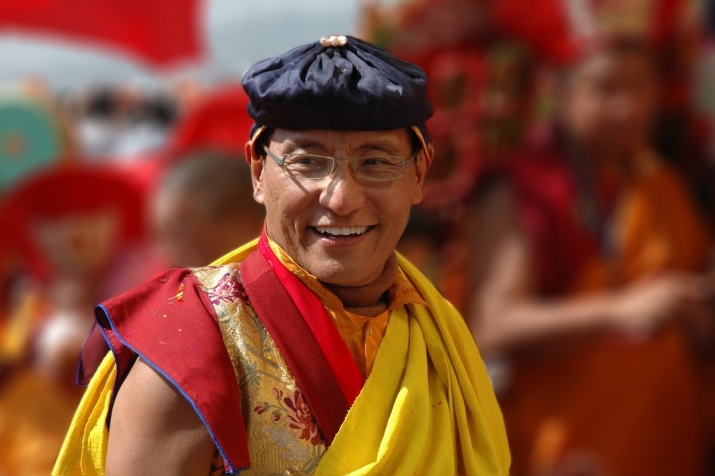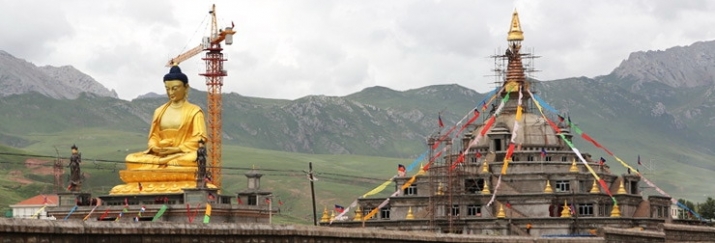NEWS
The Gyalwang Drukpa to Unveil Restored Ashoka Stupa in Nangchen, China
 HH the 12th Gyalwang Drukpa. From bellbajao.org
HH the 12th Gyalwang Drukpa. From bellbajao.orgA restored 2,000-year-old stupa that is believed to have been commissioned by the ancient Indian emperor Ashoka (r. c. 269–232 BCE) in Nangchen County, Yushu Tibetan Autonomous Prefecture in China’s Qinghai Province, is to be unveiled on Tuesday by the spiritual head of the Drukpa Kagyu lineage of Tibetan Buddhism, HH the 12th Gyalwang Drukpa. The occasion will also mark the grand enthronement of the 9th Trulshik Adeu Rinpoche.
“[The stupa] is being inaugurated with elaborate traditional ceremonies that befit the occasion. Prominent guests from across the world are coming to witness the re-initiation of this Stupa,” representatives of the Drukpa Kagyu lineage said in a statement. (The Economic Times)
The Drukpa Kagyu lineage of Tibetan Buddhism was founded in western Tibet by the ascetic monk Drogon Tsangpa Gyare (1161–1211). The school is based in Ladakh, northern India, and has more than 1,000 monasteries across the Himalayas including in Bhutan and Tibet, with 267 monastic centers in Ladakh alone.
The Gyalwang Drukpa initiated the renovation of the Nangchen stupa during his visit to Nangchen in 2007. In 2012, a 115-foot statue of the Buddha was installed at the site as part of the restoration project, which was conceived a decade earlier when His Holiness met Singapore-based businessman Felix Lim Ah Yeong.
“My wife and I met His Holiness [the Gyalwang Drupka] 10 years ago in Bali. He mentioned that one of his ambitions was to rebuild the Amitabha stupa. We agreed to take up the project,” Lim said when the statue was inaugurated. “The Buddha statue alone is worth US$6 million. It took 10 years for a Bhutanese sculptor to complete the model, after which he died. We took the model to a factory in Nanjing that specializes in making Buddha statues.” (The Hindu)
 The stupa site under renovation. From furuifoundation.com
The stupa site under renovation. From furuifoundation.comThe emperor Ashoka is notable not only for ruling over most of the Indian subcontinent, but also for converting to and propagating Buddhism. The stupa is one of 8,400 commissioned by Ashoka during his reign to enshrine relics of the historical Buddha, Shakyamuni. Nineteen were constructed in present-day China—although many have collapsed due to negligence and the passage of time.
While there are no verifiable records of the Nangchen stupa’s history, according to legend an old monastery once stood on the site of present-day Chamdo Monastery, to the west of the stupa, the monks of which constructed a building to house devotees who protected the stupa. The monastery was burned down during the upheavals of China’s Cultural Revolution and the stupa destroyed, leaving only an earth mound, and residents of the area used rocks from the stupa’s foundation to build houses. At around the same time, a stone pillar inscribed with the history of the stupa’s construction was unearthed, but it was removed from the area and its whereabouts are currently unknown.
Nangchen, which lies close to the Tibet Autonomous Region at an altitude of 13,000 feet, was formerly one of five independent kingdoms in the traditional Tibetan region of Kham, and was historically a significant political and trade center in eastern Tibet. After the advent of Buddhism, Nangchen produced generations of renowned Buddhist scholars, monks, and practitioners, and became known as the “abode of meditators.”
See more
2,000-year-old Ashoka Stupa to be inaugurated in China (The Economic Times)
A Time To Celebrate (nangchen.org)
Ashoka Stupa in Nangchen (nagchen.org)
2,000-year-old Ashoka stupa restored in Tibet (The Hindu)














